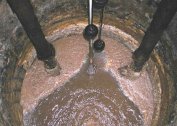If the sewer is equipped with a cesspool on the site, then you need to remember that from time to time such a pit requires maintenance with the help of a cesspool machine. As a rule, with the correct calculations of the pit volume, it is enough to use such a service once a year. However, many owners of private homes note that after several years of operation, the cesspool begins to fill up faster and it has to be cleaned more often.
Causes
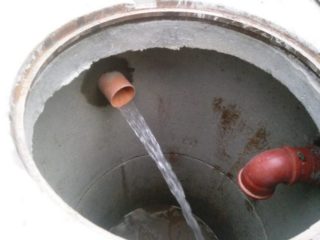 There can be many reasons for quickly filling a cesspool, but you should pay attention to the most common:
There can be many reasons for quickly filling a cesspool, but you should pay attention to the most common:
- siltation of the bottom or walls of the tank;
- damage to the drainage pipeline;
- insufficient pit volume;
- freezing of drains or the pit itself.
Also, the tank can fill up quickly due to non-operational factors. Sometimes, when designing a site, an incorrect calculation of the size of the sewer and the incoming wastewater is made.
For example, if first the wastewater had to come from the kitchen and the bathroom, and then the house expanded and was supplemented with new sources of drains, then the amount of water entering the cesspool increases, and the capacity begins to fill up faster.
Another reason why the pit fills up too quickly may be an increase in groundwater level. Often, site owners neglect geological expertise to obtain information about the depth of water. In a good way, the construction of sewerage should be carried out in the summer, when groundwater is at a minimum level. Then, when digging a trench and a sewage pit, there is no risk of colliding with groundwater. At other times of the year, during intense rains or melting snow, the groundwater level increases, which can serve as a prerequisite for accelerated filling of the tank.
Troubleshooting
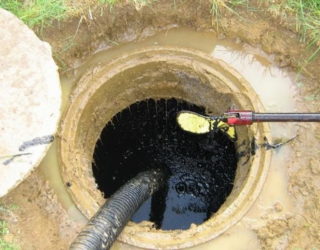 If solving problems with wastewater and improper sewer design require an individual approach, then for the most common reasons for filling the sewage pit too quickly there are several correct solutions.
If solving problems with wastewater and improper sewer design require an individual approach, then for the most common reasons for filling the sewage pit too quickly there are several correct solutions.
In the formation of sludge
If after a long use of sewage, it became increasingly difficult for sewage to escape through the walls, then most likely this happened due to the layer of silt formed on them.
To fix the problem, you can resort to the following methods:
- contact the wastewater service for the complete cleaning of the waste pit from waste;
- pour a large amount of water on the pit for a day to soften sludge;
- use special preparations with a high content of bacteria
The latter method can be noted as the most effective, since such preparations include special microorganisms that feed on biological waste and fat deposition. Therefore, they provoke accelerated decomposition and do not allow the pit to accumulate liquid too actively.
When using drugs, it is worth remembering that it is impossible at the time of their use to prevent the entry into the sewer of potent chlorine-based products, since such substances kill all useful bacteria and the whole effect of cleaning comes to naught. Also, cold weather negatively affects the effectiveness of microorganisms.
If the drainage system is malfunctioning
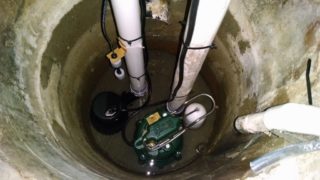 If for some reason a malfunction appears in the drainage system, a fecal pump comes to the rescue. For manual pumping, the device itself and the reservoir for the recovered waste will be required. You can also order a special pumping machine.
If for some reason a malfunction appears in the drainage system, a fecal pump comes to the rescue. For manual pumping, the device itself and the reservoir for the recovered waste will be required. You can also order a special pumping machine.
Pumps are automatic and semi-automatic. In the first case, the pump is installed in a cesspool and independently pumps out biowaste.A semi-automatic unit requires a master to carry out adjustment and control over the operation of the equipment.
Before starting treatment, it is best to add some water to the effluent to soften it. After that, the pump is turned on and waste is recovered. Then it’s better to refill and pump out again. In practice, it is better to perform such washing several times in a row, so that later the pit is filled less.
Insufficient pit volume
If a mistake was made during the calculations of the pit volume or after a long use the volume of drains increased, it is best to dig an additional pit for further connection of tanks with overflow pipes. Such a septic tank will drain and purify waste water with sufficient speed.
If the capacity of the tank is insufficient, then the tanks will also fill up too quickly. Installing a septic tank with a drainage system will solve the problem.
Freezing pits and drains
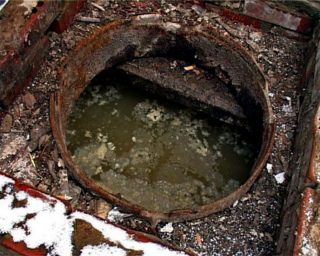 During cold weather, it happens that the pit fills up too quickly due to severe freezing of the soil, due to which sewage ceases to be absorbed into the soil. This problem is also solvable, although it will require some effort. The pipeline can be insulated with a heating cable to liquefy drains in it. The cable should be wrapped around the pipe and connected to the network. It is best to use a self-regulating cable that evens out the temperature across all areas of the collector as it changes.
During cold weather, it happens that the pit fills up too quickly due to severe freezing of the soil, due to which sewage ceases to be absorbed into the soil. This problem is also solvable, although it will require some effort. The pipeline can be insulated with a heating cable to liquefy drains in it. The cable should be wrapped around the pipe and connected to the network. It is best to use a self-regulating cable that evens out the temperature across all areas of the collector as it changes.
You can also build the heating of sludge in the pit of a private septic tank. To do this, you need a long wire with a plug for connecting to the network, a metal rod the size of a pit depth and hot water. The action plan is as follows:
- First, the sludge warms up with hot water. Simply pour it in sufficient quantities into the pit. If possible, you can heat the effluents in a private septic tank with an industrial hairdryer.
- Then one side of the metal pin is heated by fire and driven into the sludge, deepening the metal into the ground.
- The bare wire from the end is wound on the upper end of the rod, and the plug is connected to the network.
- Due to the work of frozen soil as an excellent conductor of current, the sludge in the septic tank warms up and outflow of water from the pit occurs.
It is important to note that such a warm-up can take a considerable amount of time: from 12 to 24 hours.
In the case of freezing sewage, the procedure is similar.
It is necessary to strip the copper wire, the length of which is equal to the diameter of the pipe times 3.14. This wire wraps the pipeline, and its end plugs into the outlet. So, for the next 2-4 hours, the pipes will be energized, due to which the pipes will defrost. Frozen water will melt, and the liquid will go into the soil. It is recommended to use a self-regulating wire for these purposes, so that the temperature is evenly distributed over all areas of the pipeline.
In the case of plastic pipes, it is best to use special equipment to heat the water supplied to the sewer. For such cases, there are devices that supply electric current to the pipe. Nevertheless, it is not recommended to work with such equipment to people without experience.
Problem prevention
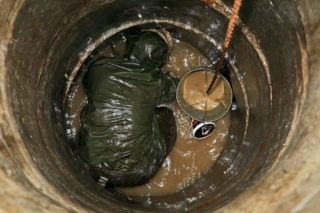 In order for the cesspool to not fill up too quickly, you must adhere to the operating rules and from time to time carry out preventive procedures.
In order for the cesspool to not fill up too quickly, you must adhere to the operating rules and from time to time carry out preventive procedures.
Basic rules for the prevention of problems in cesspools:
- regular washing of the container with clean water under high pressure, at least once every 6-8 weeks;
- timely pumping of waste from the pit;
- periodic use of biological products containing microorganisms to prevent clogging after cleaning the cesspool.
Siltation
To prevent sludge or grease deposits from forming in the tank, it is recommended to equip all sanitary fixtures in the house with special grease traps. In particular, it affects kitchen sinks through which greasy biowaste mainly passes.Also, the use of filters will increase the efficiency of such a system.
Freezing
To prevent the cesspool from freezing in winter, it is best to install thermal insulation in advance or to warm the pits and pipes from time to time.
During the design of sewers, it makes sense to think in advance about leaving some space for thermal insulation.
In order not to encounter any of the above problems, it is worthwhile to think through all the nuances of operating the sewer system in advance and proceed from the possible needs for the construction of additional elements during its construction. If you still encounter a problem such as filling the cesspool too quickly - do not worry, everything can be fixed.
